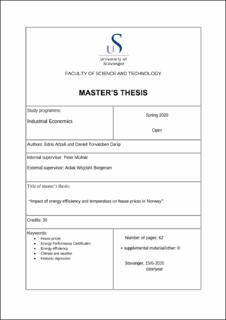| dc.contributor.advisor | Molnár, Peter | |
| dc.contributor.advisor | Bergersen, Aslak Wigdahl | |
| dc.contributor.author | Garip, Daniel Torvaldsen | |
| dc.contributor.author | Afzali, Edris | |
| dc.date.accessioned | 2020-10-12T08:11:06Z | |
| dc.date.available | 2020-10-12T08:11:06Z | |
| dc.date.issued | 2020-06-15 | |
| dc.identifier.uri | https://hdl.handle.net/11250/2682127 | |
| dc.description | Master's thesis in Industrial economics | en_US |
| dc.description.abstract | The thesis consists of two separate studies, where both have their own abstract, content-list, chapters and reference-list. We first present study one: "Impact of energy efficiency on house prices and the role of temperature" and then study two: "Impact of temperature on house prices in Norway". The first study has been our main focus, and is the more comprehensive work of the two studies.
"Impact of energy efficiency on house prices and the role of temperature":
Energy Performance Certificate, a measure of a dwelling’s energy efficiency, is a legislatively approved instrument for reducing energy consumption in households. We empirically investigate the impact of energy efficiency on house prices and how the impact vary with the type of dwelling and in disparate climate zones using average temperature. To accomplish this, we utilize Norwegian microdata, through a large and detailed dataset covering 222 392 dwellings with energy ratings. We find that there are increasing price premiums with increasing energy efficiency, and the effect is more significant for detached houses compared to apartments. Furthermore, the energy efficiency of buildings is valued more for houses in cold areas.
"Impact of temperature on house prices in Norway"
Abstract 2: Meteorological conditions are used as a determining factor in relocation decisions, and the cost of nice weather is often referred to as an amenity. We utilize temperature data from Norway and apply the common hedonic pricing method to determine the impact of different temperature transformations on house prices. When utilizing the temperature as a climate variable, we find that the different temperature transformations are almost equally good, with HDD being the slightly better transformation. The results suggest that overall in Norway, temperature is an amenity, and higher winter temperatures are slightly more appreciated compared to summer. Our dataset consists of well-detailed house transactions and weather data with good spatial distribution, and this research can serve as a base for future research. | en_US |
| dc.language.iso | eng | en_US |
| dc.publisher | University of Stavanger, Norway | en_US |
| dc.relation.ispartofseries | Masteroppgave/UIS-TN-ISØP/2020; | |
| dc.rights | Navngivelse 4.0 Internasjonal | * |
| dc.rights | Navngivelse 4.0 Internasjonal | * |
| dc.rights.uri | http://creativecommons.org/licenses/by/4.0/deed.no | * |
| dc.subject | industriell økonomi | en_US |
| dc.subject | house prices | en_US |
| dc.subject | energy efficiency | en_US |
| dc.subject | climate and weather | en_US |
| dc.subject | hedonic regression | en_US |
| dc.subject | industrial economics | en_US |
| dc.subject | energy performance certificate | en_US |
| dc.subject | boligpriser | en_US |
| dc.subject | klima og vær | en_US |
| dc.title | Impact of energy efficiency and temperature on house prices in Norway | en_US |
| dc.type | Master thesis | en_US |
| dc.subject.nsi | VDP::Samfunnsvitenskap: 200::Økonomi: 210 | en_US |

